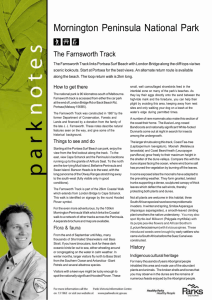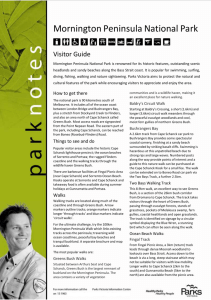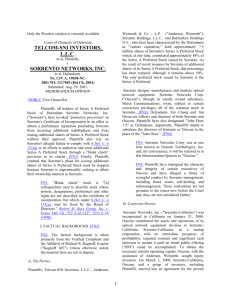Microsoft Word - MPNP - A4 Coppins Track
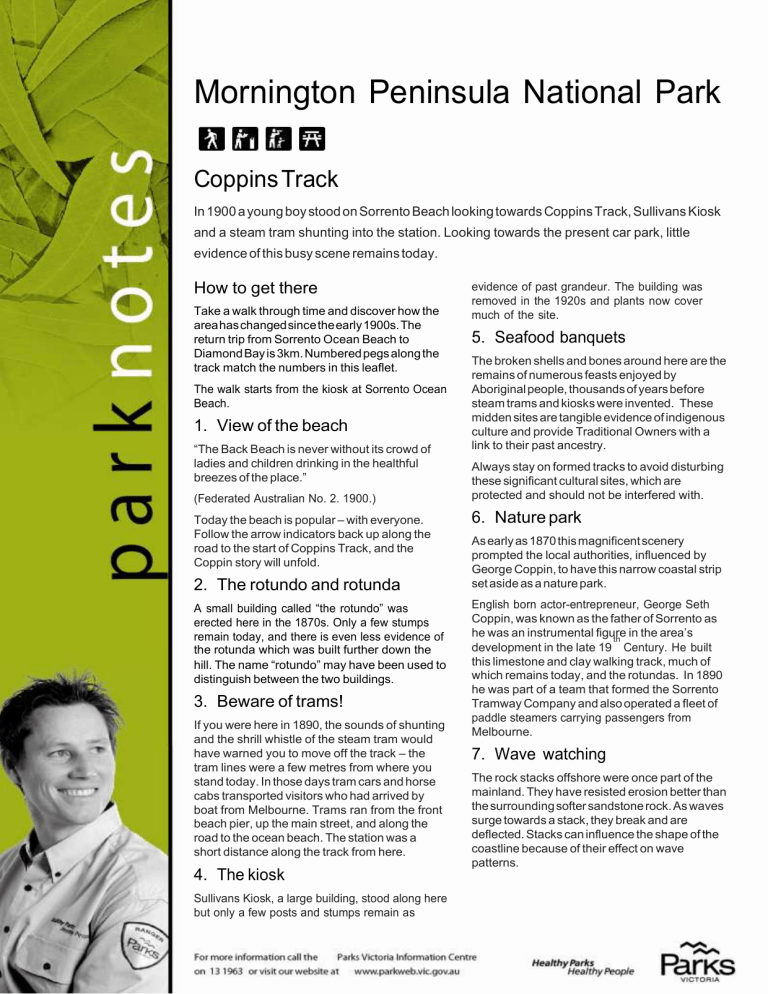
Mornington Peninsula National Park
Coppins Track
In 1900 a young boy stood on Sorrento Beach looking towards Coppins Track, Sullivans Kiosk and a steam tram shunting into the station. Looking towards the present car park, little evidence of this busy scene remains today.
How to get there
Take a walk through time and discover how the area has changed since the early 1900s. The return trip from Sorrento Ocean Beach to
Diamond Bay is 3km. Numbered pegs along the track match the numbers in this leaflet.
The walk starts from the kiosk at Sorrento Ocean
Beach.
1. View of the beach
“The Back Beach is never without its crowd of ladies and children drinking in the healthful breezes of the place .”
(Federated Australian No. 2. 1900.)
Today the beach is popular – with everyone.
Follow the arrow indicators back up along the road to the start of Coppins Track, and the
Coppin story will unfold.
2. The rotundo and rotunda
A small building called “the rotundo” was erected here in the 1870s. Only a few stumps remain today, and there is even less evidence of the rotunda which was built further down the hill. The name “rotundo” may have been used to distinguish between the two buildings.
3. Beware of trams!
If you were here in 1890, the sounds of shunting and the shrill whistle of the steam tram would have warned you to move off the track – the tram lines were a few metres from where you stand today. In those days tram cars and horse cabs transported visitors who had arrived by boat from Melbourne. Trams ran from the front beach pier, up the main street, and along the road to the ocean beach. The station was a short distance along the track from here.
4. The kiosk
Sullivans Kiosk, a large building, stood along here but only a few posts and stumps remain as evidence of past grandeur. The building was removed in the 1920s and plants now cover much of the site.
5. Seafood banquets
The broken shells and bones around here are the remains of numerous feasts enjoyed by
Aboriginal people, thousands of years before steam trams and kiosks were invented. These midden sites are tangible evidence of indigenous culture and provide Traditional Owners with a link to their past ancestry.
Always stay on formed tracks to avoid disturbing these significant cultural sites, which are protected and should not be interfered with.
6. Nature park
As early as 1870 this magnificent scenery prompted the local authorities, influenced by
George Coppin, to have this narrow coastal strip set aside as a nature park.
English born actor-entrepreneur, George Seth
Coppin, was known as the father of Sorrento as he was an instrumental figure in the are a’s th development in the late 19 Century. He built this limestone and clay walking track, much of which remains today, and the rotundas. In 1890 he was part of a team that formed the Sorrento
Tramway Company and also operated a fleet of paddle steamers carrying passengers from
Melbourne.
7. Wave watching
The rock stacks offshore were once part of the mainland. They have resisted erosion better than the surrounding softer sandstone rock. As waves surge towards a stack, they break and are deflected. Stacks can influence the shape of the coastline because of their effect on wave patterns.
For further information
Call Parks Victoria on 13 1963 or visit www.parks.vic.gov.au
Park Office
44 Hinton Street
P.O. Box 400, Rosebud
Call 5986 9100
Point Nepean Visitor Centre
Point Nepean Rd, Portsea
Call 5984 4276
Caring for the environment
Help us look after your park by following these guidelines:
Please take rubbish home with you for recycling and disposal.
Keep to the formed walking tracks.
Bicycles are not permitted on walking tracks.
Dogs are prohibited in Greens
Bush and along the coast from
Gunnamatta to Bushrangers
Bay.
Dogs are permitted in some locations along the coast between sunrise and
9:00am only.
In areas where dogs are permitted, they must be on a lead at all times.
Firearms are not permitted in the park.
Fires are not permitted in the park.
All native plants and animals are protected. Leave the park as you found it.
8. Dune mosaics
The green, grey and blue-green mosaic on these enormous sand dunes reflects a diversity of plant life. The salt-laden winds and shifting sand dunes make for a harsh environment to live in so many species have specialised adaptations to cope.
These may include thicker leaves to protect against salt spray or fine hairs which help to avoid heat stress and prevent dehydration.
9. Shipwrecks
Tragically, the very ocean you are admiring has on numerous occasions reduced sturdy ships to matchwood. One victim, the Sierra Nevada, struck rocks near London Bridge on 9 May 1900.
10. An exotic to the rescue?
Each of the marram grass plants on this dune was planted by hand on the bare sand in an attempt to prevent the dune from ‘blowing out’ any further. The exotic species was once a popular way of controlling erosion but has now become a problematic weed on our coasts. Its vigorous growth and ability to trap large amounts of sand has changed the natural structure of the dunes. Marram grass spreads quickly and out competes native grasses, affecting plant communities and native animal habitat.
11. Brushing helps too
Along this section of track, brushing has been used to encourage native plants to grow back.
The Tea-tree brush has been wired down to protect young seedlings from salt and sand-laden winds.
Over the years, careless walkers have trampled plants, causing erosion and encouraging the growth of weeds.
12. The land grabbers
These cliffs are being constantly worn back by heavy seas, sand and salt blasting, temperature changes and other agents of weathering. In places, the original Coppins Track has disappeared, either over the cliff or under the sand. Where will this track be in 100 years time?
Follow the track to reach the steps to St Pauls
Beach.
13. St Pauls beach
Healthy Parks Healthy People
Visiting a park can improve your health, mind, body and soul. So, with over four million hectares of parkland available to Victorians, why not escape to a park today !
A short detour along the side track provides a good view of “fossilised” sand dunes. They consist of sand bound together by lime derived from shells. The cliff face on the Sorrento side of the cove clearly shows the layers formed in ancient “dune rock”, and major breaks between dunes of different ages.
Steps lead down to St Pauls beach.
Walk back up to Coppins Track and continue towards Diamond Bay.
14. A different mosaic
As at Stop 8, native plants form a mosaic covering these dunes. Here though, two plants are dominant: Coast Beard-heath (Leucopogon parviflorus) and Coast Tea-tree ( Leptospermum laevigatum) . The dense vegetation is good habitat for many birds; you may hear several species if you listen carefully.
You may also spot two invasive species, both native to South Africa. Unfortunately Myrtle-leaf
Milkwort ( Polygala myrtifolia) with its purple pea-like flowers and African Boxthorn ( Lycium ferocissimum) with it vicious spines, have become problematic weeds along the coast.
Continue along the track and take the right hand fork to Jubilee Point.
15. Jubilee Point
On a clear day, Jubilee Point commands fine views of Cape Schanck to the east, and as far as the Otways to the west.
In the early 19 th
Century, a rotunda was built on this site. If you look carefully, you may find a few stumps, but nothing else remains. It was demolished in World War 2 to clear the coastline of landmarks that could be recognised by enemy forces.
From here you can retrace your steps, or follow
Coppins Track to Diamond Bay, another 1km.
Arriving at the Sorrento Ocean Beach by tram and horse cab.
The track on the right follows the line of the present road while the tram line is now largely overgrown.
Thanks to Latrobe Library and the Nepean Historical
Society for help in the original preparation of this publication.
Printed on 100% Australian-made recycled paper
Updated March 2012






![PERSONAL COMPUTERS CMPE 3 [Class # 20524]](http://s2.studylib.net/store/data/005319327_1-bc28b45eaf5c481cf19c91f412881c12-300x300.png)
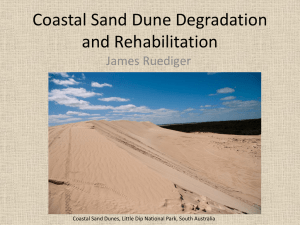
![Beach Task Force June 19 2014[Icon]](http://s3.studylib.net/store/data/007024040_1-770d150c49a9dddb60a7072fd7d9b509-300x300.png)
